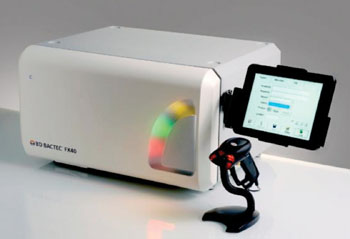Positive Blood Culture Removal Time Significantly Decreases Processing Time
|
By LabMedica International staff writers Posted on 18 Feb 2015 |
Timely processing of blood cultures with positive results, including Gram staining and notification of clinicians, is a critical function of the clinical microbiology laboratory.
Although empiric administration of antibiotics is critical, targeted therapy based on actionable data from the clinical microbiology laboratory must be implemented as soon as the data are available as inadequate antimicrobial treatment of bloodstream infections is associated with significantly increased mortality and, in surviving patients, increased hospital length of stay.
Scientists at the Houston Methodist Hospital (TX, USA) performed a retrospective analysis of positive blood culture processing times. Data for specimens collected seven months before and seven months after an in-service meeting were retrieved and analyzed. In some instances, no organisms were seen on initial Gram stain after a positive alert. In those cases, the culture bottles were returned to the automated blood culture system BACTEC FX instrument (BD Diagnostics, Sparks, MD, USA) for further incubation. As the Epicenter software does not log the initial removal, the positive-to-removal (PR) time was erroneously prolonged, and these samples were excluded from the analysis.
Before the in-service meeting, the average PR time for 5,057 samples was 38 minutes. They discovered unexpectedly that only 51.8% (2,617 of 5,057) of the positive blood cultures were removed in less than 10 minutes. After the in-service meeting, for 5,293 samples, the average PR time improved to eight minutes, the aggregate time also improved, and 84.5% (4,470 of 5,293) of the positive blood cultures were removed in less than 10 minutes. These improvements reduced the time to telephone notification of the Gram stain results to a caregiver by 46.7% (from 105 minutes to 56 minutes).
The authors concluded improvement of sepsis outcomes and costs requires rapid generation of actionable data from the clinical microbiology laboratory. Vigilant monitoring of parameters such as the PR time and meticulous identification of barriers to rapid pathogen identification has the potential to continue to decrease pathogen reporting time, decrease health care costs, and decrease morbidity and mortality associated with bloodstream infections. The study was published in the February 2015 issue of the Archives of Pathology & Laboratory Medicine.
Related Links:
Houston Methodist Hospital
BD Diagnostics
Although empiric administration of antibiotics is critical, targeted therapy based on actionable data from the clinical microbiology laboratory must be implemented as soon as the data are available as inadequate antimicrobial treatment of bloodstream infections is associated with significantly increased mortality and, in surviving patients, increased hospital length of stay.
Scientists at the Houston Methodist Hospital (TX, USA) performed a retrospective analysis of positive blood culture processing times. Data for specimens collected seven months before and seven months after an in-service meeting were retrieved and analyzed. In some instances, no organisms were seen on initial Gram stain after a positive alert. In those cases, the culture bottles were returned to the automated blood culture system BACTEC FX instrument (BD Diagnostics, Sparks, MD, USA) for further incubation. As the Epicenter software does not log the initial removal, the positive-to-removal (PR) time was erroneously prolonged, and these samples were excluded from the analysis.
Before the in-service meeting, the average PR time for 5,057 samples was 38 minutes. They discovered unexpectedly that only 51.8% (2,617 of 5,057) of the positive blood cultures were removed in less than 10 minutes. After the in-service meeting, for 5,293 samples, the average PR time improved to eight minutes, the aggregate time also improved, and 84.5% (4,470 of 5,293) of the positive blood cultures were removed in less than 10 minutes. These improvements reduced the time to telephone notification of the Gram stain results to a caregiver by 46.7% (from 105 minutes to 56 minutes).
The authors concluded improvement of sepsis outcomes and costs requires rapid generation of actionable data from the clinical microbiology laboratory. Vigilant monitoring of parameters such as the PR time and meticulous identification of barriers to rapid pathogen identification has the potential to continue to decrease pathogen reporting time, decrease health care costs, and decrease morbidity and mortality associated with bloodstream infections. The study was published in the February 2015 issue of the Archives of Pathology & Laboratory Medicine.
Related Links:
Houston Methodist Hospital
BD Diagnostics
Read the full article by registering today, it's FREE! 

Register now for FREE to LabMedica.com and get access to news and events that shape the world of Clinical Laboratory Medicine. 
- Free digital version edition of LabMedica International sent by email on regular basis
- Free print version of LabMedica International magazine (available only outside USA and Canada).
- Free and unlimited access to back issues of LabMedica International in digital format
- Free LabMedica International Newsletter sent every week containing the latest news
- Free breaking news sent via email
- Free access to Events Calendar
- Free access to LinkXpress new product services
- REGISTRATION IS FREE AND EASY!
Sign in: Registered website members
Sign in: Registered magazine subscribers
Latest Microbiology News
- Blood-Based Diagnostic Method Could Identify Pediatric LRTIs
- Rapid Diagnostic Test Matches Gold Standard for Sepsis Detection
- Rapid POC Tuberculosis Test Provides Results Within 15 Minutes
- Rapid Assay Identifies Bloodstream Infection Pathogens Directly from Patient Samples
- Blood-Based Molecular Signatures to Enable Rapid EPTB Diagnosis
- 15-Minute Blood Test Diagnoses Life-Threatening Infections in Children
- High-Throughput Enteric Panels Detect Multiple GI Bacterial Infections from Single Stool Swab Sample
- Fast Noninvasive Bedside Test Uses Sugar Fingerprint to Detect Fungal Infections
- Rapid Sepsis Diagnostic Device to Enable Personalized Critical Care for ICU Patients
- Microfluidic Platform Assesses Neutrophil Function in Sepsis Patients
- New Diagnostic Method Confirms Sepsis Infections Earlier
- New Markers Could Predict Risk of Severe Chlamydia Infection
- Portable Spectroscopy Rapidly and Noninvasively Detects Bacterial Species in Vaginal Fluid
- CRISPR-Based Saliva Test Detects Tuberculosis Directly from Sputum
- Urine-Based Assay Diagnoses Common Lung Infection in Immunocompromised People
- Saliva Test Detects Implant-Related Microbial Risks
Channels
Clinical Chemistry
view channel
Chemical Imaging Probe Could Track and Treat Prostate Cancer
Prostate cancer remains a leading cause of illness and death among men, with many patients eventually developing resistance to standard hormone-blocking therapies. These drugs often lose effectiveness... Read more
Mismatch Between Two Common Kidney Function Tests Indicates Serious Health Problems
Creatinine has long been the standard for measuring kidney filtration, while cystatin C — a protein produced by all human cells — has been recommended as a complementary marker because it is influenced... Read moreMolecular Diagnostics
view channel
Blood Test Enables Non-Invasive Endometriosis Detection
Endometriosis is a chronic, complex, yet relatively common gynecological disorder, reportedly affecting 1 in 10 adult and adolescent women. Endometriosis causes tissue similar to the lining of the uterus... Read more
New Blood Biomarkers Help Diagnose Pregnancy-Linked Liver Complication
Intrahepatic cholestasis of pregnancy (ICP) is the most common liver disorder linked to pregnancy and can pose serious risks for both mother and baby, including premature delivery and stillbirth.... Read moreHematology
view channel
MRD Tests Could Predict Survival in Leukemia Patients
Acute myeloid leukemia is an aggressive blood cancer that disrupts normal blood cell production and often relapses even after intensive treatment. Clinicians currently lack early, reliable markers to predict... Read more
Platelet Activity Blood Test in Middle Age Could Identify Early Alzheimer’s Risk
Early detection of Alzheimer’s disease remains one of the biggest unmet needs in neurology, particularly because the biological changes underlying the disorder begin decades before memory symptoms appear.... Read more
Microvesicles Measurement Could Detect Vascular Injury in Sickle Cell Disease Patients
Assessing disease severity in sickle cell disease (SCD) remains challenging, especially when trying to predict hemolysis, vascular injury, and risk of complications such as vaso-occlusive crises.... Read more
ADLM’s New Coagulation Testing Guidance to Improve Care for Patients on Blood Thinners
Direct oral anticoagulants (DOACs) are one of the most common types of blood thinners. Patients take them to prevent a host of complications that could arise from blood clotting, including stroke, deep... Read moreImmunology
view channel
Routine Blood Test Can Predict Who Benefits Most from CAR T-Cell Therapy
CAR T-cell therapy has transformed treatment for patients with relapsed or treatment-resistant non-Hodgkin lymphoma, but many patients eventually relapse despite an initial response. Clinicians currently... Read more
New Test Distinguishes Vaccine-Induced False Positives from Active HIV Infection
Since HIV was identified in 1983, more than 91 million people have contracted the virus, and over 44 million have died from related causes. Today, nearly 40 million individuals worldwide live with HIV-1,... Read more
Gene Signature Test Predicts Response to Key Breast Cancer Treatment
DK4/6 inhibitors paired with hormone therapy have become a cornerstone treatment for advanced HR+/HER2– breast cancer, slowing tumor growth by blocking key proteins that drive cell division.... Read more
Chip Captures Cancer Cells from Blood to Help Select Right Breast Cancer Treatment
Ductal carcinoma in situ (DCIS) accounts for about a quarter of all breast cancer cases and generally carries a good prognosis. This non-invasive form of the disease may or may not become life-threatening.... Read morePathology
view channel
Rapid Low-Cost Tests Can Prevent Child Deaths from Contaminated Medicinal Syrups
Medicinal syrups contaminated with toxic chemicals have caused the deaths of hundreds of children worldwide, exposing a critical gap in how these products are tested before reaching patients.... Read more
Tumor Signals in Saliva and Blood Enable Non-Invasive Monitoring of Head and Neck Cancer
Head and neck cancers are among the most aggressive malignancies worldwide, with nearly 900,000 new cases diagnosed each year. Monitoring these cancers for recurrence or relapse typically relies on tissue... Read more
Common Health Issues Can Influence New Blood Tests for Alzheimer’s Disease
Blood-based tests for Alzheimer’s disease are transforming diagnosis by offering a simpler alternative to spinal taps and brain imaging. However, many people evaluated at memory clinics also live with... Read more
Blood Test Formula Identifies Chronic Liver Disease Patients with Higher Cancer Risk
Chronic liver disease affects millions worldwide and can progress silently to hepatocellular carcinoma (HCC), one of the deadliest cancers globally. While surveillance guidelines exist for patients with... Read moreTechnology
view channel
Artificial Intelligence Model Could Accelerate Rare Disease Diagnosis
Identifying which genetic variants actually cause disease remains one of the biggest challenges in genomic medicine. Each person carries tens of thousands of DNA changes, yet only a few meaningfully alter... Read more
AI Saliva Sensor Enables Early Detection of Head and Neck Cancer
Early detection of head and neck cancer remains difficult because the disease produces few or no symptoms in its earliest stages, and lesions often lie deep within the head or neck, where biopsy or endoscopy... Read moreIndustry
view channel
Abbott Acquires Cancer-Screening Company Exact Sciences
Abbott (Abbott Park, IL, USA) has entered into a definitive agreement to acquire Exact Sciences (Madison, WI, USA), enabling it to enter and lead in fast-growing cancer diagnostics segments.... Read more





















